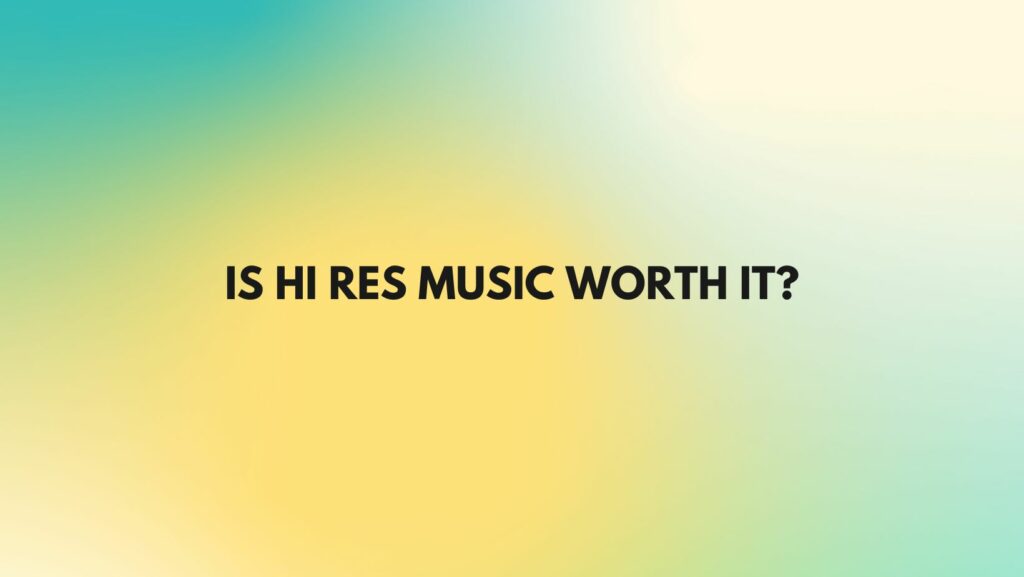In the realm of digital music, the concept of high-resolution (hi-res) audio has gained significant traction, promising an enhanced listening experience compared to standard CD-quality audio. But is hi-res music truly worth the investment, or is it merely a marketing gimmick? To answer this question, it’s essential to delve into the technical aspects of audio formats and explore the subjective factors that influence our perception of sound quality.
Understanding Audio Formats: Bit Depth and Sampling Rate
Digital audio files are essentially a series of binary numbers representing the amplitude of sound waves at discrete points in time. The two key parameters that define the quality of digital audio are bit depth and sampling rate.
-
Bit depth: Bit depth determines the range of amplitude values that can be represented, analogous to the number of shades of gray in an image. Higher bit depth allows for more precise representation of sound waves, potentially leading to a more nuanced and detailed listening experience.
-
Sampling rate: Sampling rate refers to the frequency at which sound waves are sampled, essentially capturing snapshots of the waveform at regular intervals. A higher sampling rate captures more of the intricate details of the sound, potentially resulting in a more faithful reproduction of the original recording.
CD-Quality Audio: The Benchmark
CD-quality audio, the standard for digital music for decades, utilizes a bit depth of 16 bits and a sampling rate of 44.1kHz. This combination has been widely accepted as providing a satisfactory listening experience for most listeners.
High-Resolution Audio: Raising the Bar
Hi-res audio encompasses a range of formats that exceed the specifications of CD-quality audio. Common hi-res formats include:
-
24-bit/48kHz: This format offers a higher bit depth and a slightly higher sampling rate compared to CD quality.
-
24-bit/96kHz: This format doubles the sampling rate of CD quality while maintaining the same bit depth.
-
24-bit/192kHz: Quadruples the sampling rate of CD quality while maintaining the same bit depth.
The Subjective Experience: Perception and Preferences
The perception of audio quality is subjective, influenced by individual hearing sensitivity, listening equipment, and musical preferences. While hi-res audio theoretically offers a wider dynamic range and potentially more accurate reproduction of the original recording, the extent to which these benefits are perceptible is a matter of debate.
Studies have shown that some individuals with trained hearing can discern subtle differences between hi-res audio and CD-quality audio, particularly in terms of clarity and detail retrieval. However, for the average listener, the differences may be less apparent or even inaudible.
Factors Influencing Audio Quality
Apart from the audio format itself, several other factors contribute to the overall quality of the listening experience:
-
Source material: The quality of the original recording plays a significant role in determining the final sound quality. A well-recorded and mastered track will benefit more from hi-res encoding compared to a poorly recorded one.
-
Digital-to-analog converter (DAC): The DAC is responsible for converting the digital audio signal back into an analog signal that can be amplified by speakers. A high-quality DAC is crucial for extracting the full potential of hi-res audio.
-
Listening equipment: The quality of speakers or headphones also plays a role in the perception of audio quality. High-end speakers or headphones with a wide frequency response and accurate reproduction are necessary to fully appreciate the nuances of hi-res audio.
Conclusion: Weighing the Cost and Benefits
Hi-res audio offers the potential for enhanced sound quality, particularly for discerning listeners with high-quality equipment. However, the cost of hi-res music and the subjective nature of its perceived benefits make it a matter of personal preference and investment.
For audiophiles seeking the ultimate in sonic purity and those who possess the equipment to fully appreciate hi-res audio, the investment may be worthwhile. However, for the average listener, CD-quality audio remains a viable and enjoyable option. Ultimately, the decision of whether to pursue hi-res audio should be based on individual preferences, listening habits, and budgetary considerations.


